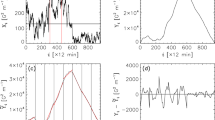Abstract
The NOAA listings of solar flares in cycles 21 – 24, including the GOES soft X-ray magnitudes, enable a simple determination of the number of flares each flaring active region produces over its lifetime. We have studied this measure of flare productivity over the interval 1975 – 2012. The annual averages of flare productivity remained approximately constant during cycles 21 and 22, at about two reported M- or X-flares per region, but then increased significantly in the declining phase of cycle 23 (the years 2004 – 2005). We have confirmed this by using the independent RHESSI flare catalog to check the NOAA events listings where possible. We note that this measure of solar activity does not correlate with the solar cycle. The anomalous peak in flare productivity immediately preceded the long solar minimum between cycles 23 and 24.





Similar content being viewed by others
References
Abramenko, V.I.: 2005, Relationship between magnetic power spectrum and flare productivity in solar active regions. Astrophys. J. 629, 1141 – 1149. doi: 10.1086/431732 .
Albregtsen, F., Maltby, P.: 1981, Solar cycle variation of sunspot intensity. Solar Phys. 71, 269 – 283. doi: 10.1007/BF00167551 .
Dalla, S., Fletcher, L., Walton, N.A.: 2007, Flare productivity of newly-emerged paired and isolated solar active regions. Astron. Astrophys. 468, 1103 – 1108. doi: 10.1051/0004-6361:20077177 .
Freeland, S.L., Handy, B.N.: 1998, Data analysis with the SolarSoft system. Solar Phys. 182, 497 – 500. doi: 10.1023/A:1005038224881 .
Fröhlich, C.: 2013, Total solar irradiance: What have we learned from the last three cycles and the recent minimum? Space Sci. Rev. 176, 237 – 252. doi: 10.1007/s11214-011-9780-1 .
Gaizauskas, V.: 1982, The relation of solar flares to the evolution and proper motions of magnetic fields. Adv. Space Res. 2, 11 – 30. doi: 10.1016/0273-1177(82)90175-2 .
Heyvaerts, J., Priest, E.R.: 1984, Coronal heating by reconnection in DC current systems – A theory based on Taylor’s hypothesis. Astron. Astrophys. 137, 63 – 78.
Jing, J., Tan, C., Yuan, Y., Wang, B., Wiegelmann, T., Xu, Y., Wang, H.: 2010, Free magnetic energy and flare productivity of active regions. Astrophys. J. 713, 440 – 449. doi: 10.1088/0004-637X/713/1/440 .
Kaiser, M.L., Kucera, T.A., Davila, J.M., St. Cyr, O.C., Guhathakurta, M., Christian, E.: 2008, The STEREO mission: an introduction. Space Sci. Rev. 136, 5 – 16. doi: 10.1007/s11214-007-9277-0 .
Lin, R.P., Dennis, B.R., Hurford, G.J., Smith, D.M., Zehnder, A., Harvey, P.R., Curtis, D.W., Pankow, D., Turin, P., Bester, M., Csillaghy, A., Lewis, M., Madden, N., van Beek, H.F., Appleby, M., Raudorf, T., McTiernan, J., Ramaty, R., Schmahl, E., Schwartz, R., Krucker, S., Abiad, R., Quinn, T., Berg, P., Hashii, M., Sterling, R., Jackson, R., Pratt, R., Campbell, R.D., Malone, D., Landis, D., Barrington-Leigh, C.P., Slassi-Sennou, S., Cork, C., Clark, D., Amato, D., Orwig, L., Boyle, R., Banks, I.S., Shirey, K., Tolbert, A.K., Zarro, D., Snow, F., Thomsen, K., Henneck, R., Mchedlishvili, A., Ming, P., Fivian, M., Jordan, J., Wanner, R., Crubb, J., Preble, J., Matranga, M., Benz, A., Hudson, H., Canfield, R.C., Holman, G.D., Crannell, C., Kosugi, T., Emslie, A.G., Vilmer, N., Brown, J.C., Johns-Krull, C., Aschwanden, M., Metcalf, T., Conway, A.: 2002, The Reuven Ramaty High-Energy Solar Spectroscopic Imager (RHESSI). Solar Phys. 210, 3 – 32. doi: 10.1023/A:1022428818870 .
Low, B.C.: 1996, Solar activity and the corona. Solar Phys. 167, 217 – 265. doi: 10.1007/BF00146338 .
Mandrini, C.H., Webb, D.F. (eds.): 2012, Comparative magnetic minima: characterizing quiet times in the Sun and stars, IAU Symp. 286.
Mewaldt, R.A., Davis, A.J., Lave, K.A., Leske, R.A., Stone, E.C., Wiedenbeck, M.E., Binns, W.R., Christian, E.R., Cummings, A.C., de Nolfo, G.A., Israel, M.H., Labrador, A.W., von Rosenvinge, T.T.: 2010, Record-setting cosmic-ray intensities in 2009 and 2010. Astrophys. J. Lett. 723, L1 – L6. doi: 10.1088/2041-8205/723/1/L1 .
Penn, M.J., Livingston, W.: 2006, Temporal changes in sunspot umbral magnetic fields and temperatures. Astrophys. J. Lett. 649, L45 – L48. doi: 10.1086/508345 .
Rust, D.M.: 1994, Spawning and shedding helical magnetic fields in the solar atmosphere. Geophys. Res. Lett. 21, 241 – 244. doi: 10.1029/94GL00003 .
Schrijver, C.J.: 2007, A characteristic magnetic field pattern associated with all major solar flares and its use in flare forecasting. Astrophys. J. Lett. 655, L117 – L120. doi: 10.1086/511857 .
Tapping, K.F.: 1987, Recent solar radio astronomy at centimeter wavelengths – The temporal variability of the 10.7-cm flux. J. Geophys. Res. 92, 829 – 838. doi: 10.1029/JD092iD01p00829 .
Török, T., Kliem, B.: 2005, Confined and ejective eruptions of kink-unstable flux ropes. Astrophys. J. Lett. 630, L97 – L100. doi: 10.1086/462412 .
Watson, F.T., Fletcher, L., Marshall, S.: 2011, Evolution of sunspot properties during solar cycle 23. Astron. Astrophys. 533, A14. doi: 10.1051/0004-6361/201116655 .
Wheatland, M.S.: 2001, Rates of flaring in individual active regions. Solar Phys. 203, 87 – 106.
White, S.M., Thomas, R.J., Schwartz, R.A.: 2005, Updated expressions for determining temperatures and emission measures from GOES soft X-ray measurements. Solar Phys. 227, 231 – 248. doi: 10.1007/s11207-005-2445-z .
Zirin, H., Liggett, M.A.: 1987, Delta spots and great flares. Solar Phys. 113, 267 – 281. doi: 10.1007/BF00147707 .
Acknowledgements
Authors Hudson and McTiernan acknowledge support from NASA under Contract NAS5–98033 for RHESSI. Author Fletcher was supported by STFC rolling grant ST/I001808/1 and by the EC-funded FP7 project HESPE (FP7-2010-SPACE-1–263086).
Author information
Authors and Affiliations
Corresponding author
Rights and permissions
About this article
Cite this article
Hudson, H., Fletcher, L. & McTiernan, J. Cycle 23 Variation in Solar Flare Productivity. Sol Phys 289, 1341–1347 (2014). https://doi.org/10.1007/s11207-013-0384-7
Received:
Accepted:
Published:
Issue Date:
DOI: https://doi.org/10.1007/s11207-013-0384-7




